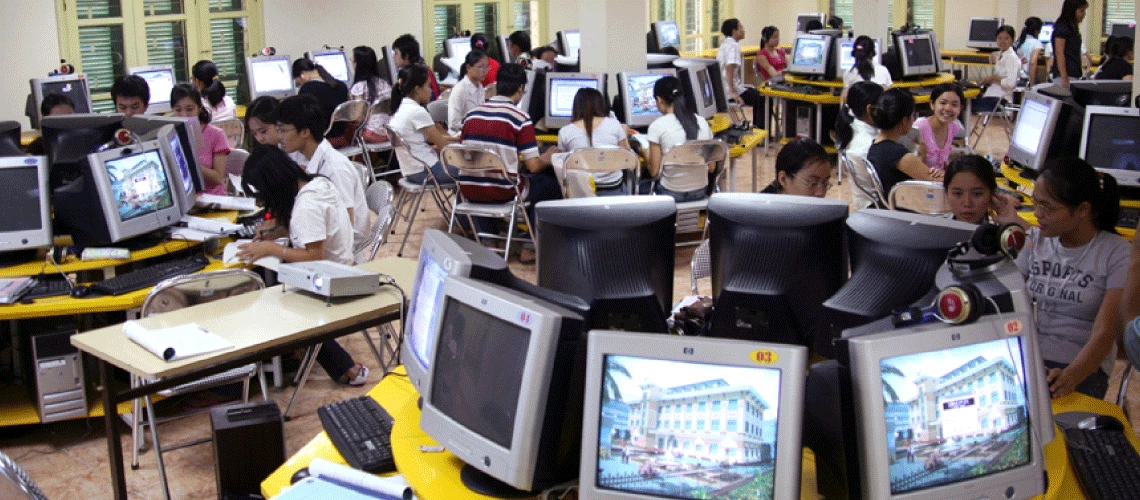 Computer lab at Hanoi University. Photo: Simone D. McCourtie / World Bank
Computer lab at Hanoi University. Photo: Simone D. McCourtie / World Bank
Following our earlier blog on the success of the German Green IT Initiative, readers enquired what green digital solutions are available or under development.
While green IT initiatives in private and public sectors differ in reach, focus, and organizational approach, we can identify several green IT solutions that have already been developed, tested, and are available to integrate into public sector digitalization. In this blog we look at a selection of five such green digital solutions and instruments and how they can contribute to a “greener” digitalization process: Green Data Centers, Cloud Solutions, Greener Hardware, Green Software Solutions, and Dark Data Management.
1. Green Data Centers
Data centers are becoming an important part of every modernization effort of government processes and public administration. Data centers—server and data storage—are the heart of information technology infrastructure. They also represent an already high and fast-growing share of overall IT energy consumption and carbon footprint. The good news is that successful concepts for greener data centers have recently been developed and put into use.
Critical and proven levers to improve their energy efficiency are, for example:
- Location of the data centers (outside temperature, proximity to networks etc.)
- Energy sources for operations (green/renewable energy)
- Energy-efficiency of hardware
- Server-virtualization and server load
- Utilization of (waste) heat given off by servers
- Cooling system optimization.
In line with political priorities, same countries—for example, Germany, Malaysia, and Denmark— have already looked at the carbon emissions and electricity- saving potential of public sector green data centers and have issued mandatory standards or specifications. Hong Kong has issued a comprehensive Green Data Centre Practice Guide.
2. Cloud Solutions
Cloud solutions offer exciting potential for increased energy efficiency of IT systems. They help bundle IT services and operations away from less efficient onside or smaller data centers to more energy-efficient and larger data centers, thus significantly reducing energy consumption, waste, and greenhouse gas (GHG) emissions. According to Microsoft Corporation and WSP Global Inc., Microsoft cloud services can be 93 percent more energy-efficient, with up to 98 percent (lower GHG emissions than onsite data centers).
Depending on market conditions, governments have a wide choice to use commercially available cloud solutions or can develop their own. The GovTech How-to Note: Cloud Computing: Cloud Assessment Framework and Evaluation Methodology offers detailed guidance on the issue.
3. Green Hardware
Procurement, use, and recycling of certified green IT hardware is another source of potentially significant means of decarbonization, better resource utilization, and environmental protection. Depending on manufacturers and the specifications, devices like personal computers, laptops, tablets, smartphones, servers, and other hardware can have very different production inputs: for example, from energy to rare metals, transportation, and social production conditions. Comparable products can also vary significantly in energy consumption while-in-use, and in longevity, repairability, and recyclability.
Policy guidelines on green public procurement can help governments to purchase greener IT hardware. Specifically designed procurement systems can make it mandatory to take energy and environmental hardware differences/criteria into account and provide grounds for preferential selection that can help reduce energy consumption and optimize the use of natural recourses.
4. Green software solutions
Working with energy-efficient software is a relatively new focus area within the search for greener IT solutions but with potentially substantial impact. Experiences and research show that the energy consumption of IT systems (for example, processor utilization) and even the lifetime expectation of IT hardware are significantly dependent on the software. While there are no robust studies yet on how much operational energy can be saved, energy-efficient or green software will become an important element of green digital solutions. Key private sector software developers are currently driving progress in this area. Accenture, GitHub, Microsoft, and ThoughtWorks launched the Green Software Foundation in 2021 to develop standards and best practices.
Governments can develop criteria, guidelines, and certification standards for software products that save energy and natural resources. Like hardware efficiency standards, updated software standards and specifications can inform and be utilized within the public procurement system and IT operations.
5. Dark Data Management
Data generated, acquired, and stored but not utilized and analyzed to draw conclusions or insights for decision-making is classified as dark data. Organizations, including the public sector, retain dark data for various reasons: limited analytical capacities, regulatory compliance, or record keeping.
Storage of this data is often considered simple and cheap, thus driving dark data’s high growth rate. Veritas—a data management company—estimates that 52 percent of all data globally stored by organizations is dark data and that the absolute amount is growing fast, from 33 zettabytes in 2018 to an estimated 175 zettabytes in 2025. Veritas’ research also indicates that dark data contributes significantly to global carbon emissions by the ICT sector (5.8 million tons in 2019.
Dark Data Management should, therefore, also be an important element of any green digital solutions package. Dark data should be managed through clear guidelines and practices, including data filters, data deletion, and improved data utilization.
Conclusion
Taking advantage of innovative green digital solutions within an overall green GovTech approach can successfully mitigate against increasing energy demands of a digitalized public sector.
The forthcoming Policy Note on Greening GovTech by the Governance Global Practice will discuss in much more detail the green and digital transitions in the public sector.
Related blogs
Germany’s green IT Initiative is cutting energy consumption and GHG emissions in its public sector


Join the Conversation